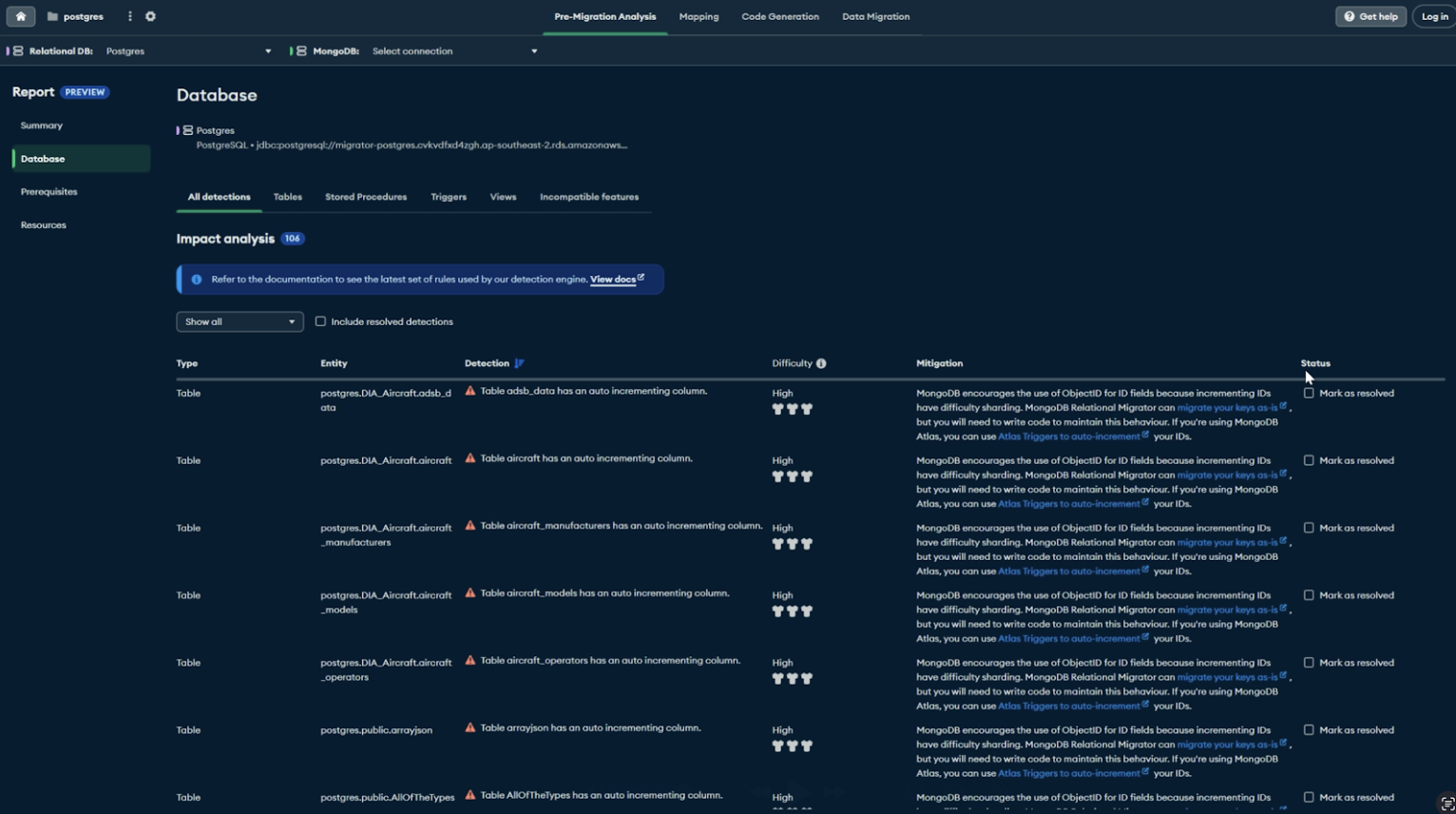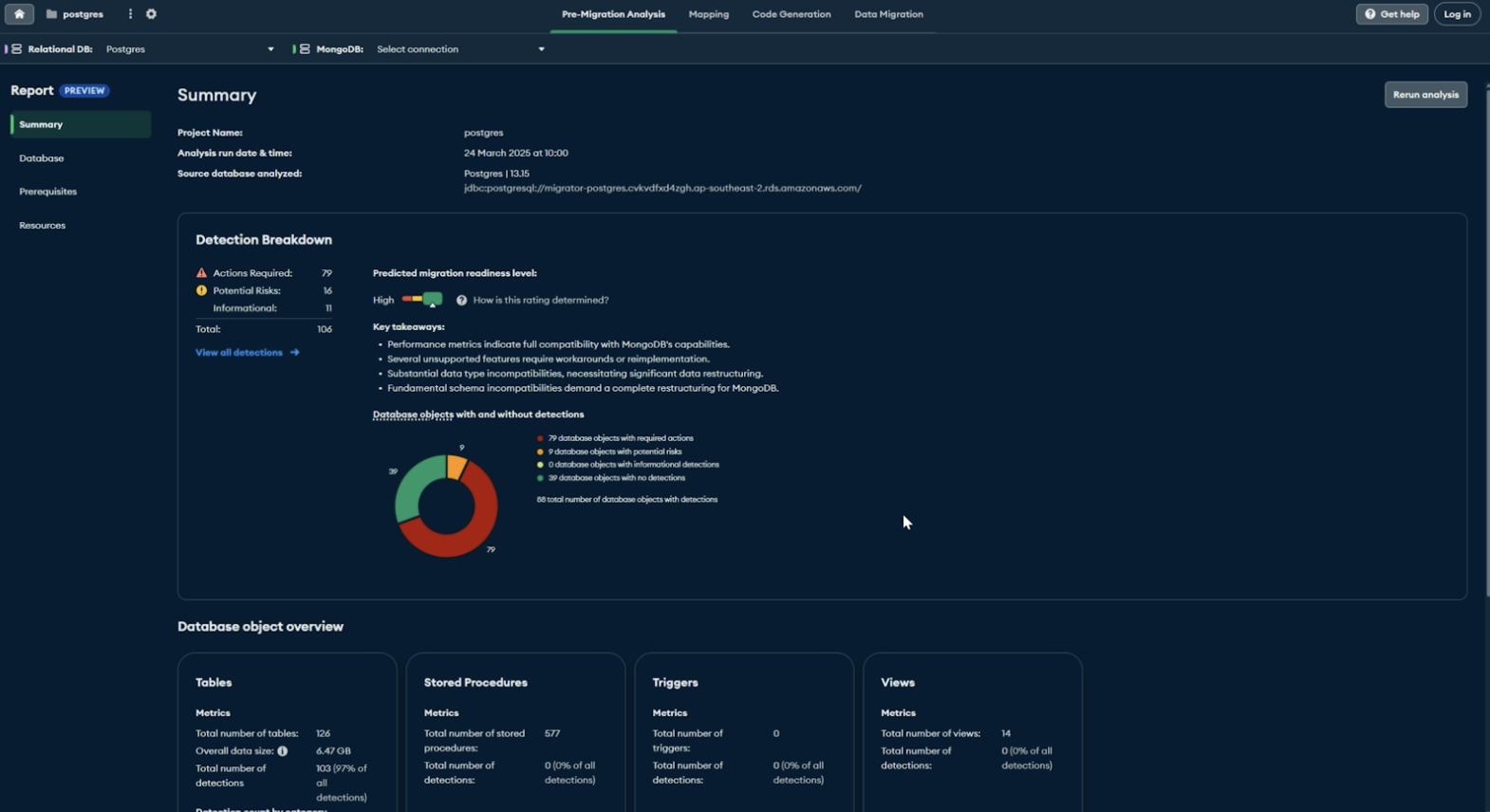When planning a complex home renovation, homeowners often turn to a team of experts to evaluate the project. Architects sketch out designs, structural engineers assess a house’s structure and foundation, and contractors estimate renovation costs and timelines. This process can take weeks or even months before construction begins, consuming valuable time and precious resources.
The same is true for database migration projects. Solution architects planning a migration from legacy relational databases to modern platforms like MongoDB rely heavily on manual assessments by expert teams. These assessments—which involve analyzing database schemas to identify potential risks—can drain resources and delay progress.
That’s where the new Pre-Migration Analysis feature in MongoDB Relational Migrator comes in. First, it uses advanced algorithms to automate much of the pre-migration evaluation process by analyzing a database’s schema. It then provides a detailed, customized report that highlights inconsistencies, flags potential issues like incompatible data types, and recommends actionable steps to ensure a successful migration to MongoDB. The report is dynamic, allowing you to refine it by marking items as completed or triaged.
By providing a clear roadmap, this feature empowers you to plan and execute migrations with confidence while saving time and minimizing risk.
Why use Pre-Migration Analysis?
There are a number of benefits associated with using the new Pre-Migration Analysis tool, from faster migrations to the convenience of reporting.
Here are some of the areas Pre-Migration Analysis can help with:
-
Minimized disruption: Migration planning often feels overwhelming because it risks diverting focus from your core business operations. A precise, detailed analysis upfront helps you avoid unnecessary disruptions by providing recommendations for success, saving your team from spinning its wheels and wasting resources.
-
Accurate resource allocation: Without a proper assessment, it’s hard to gauge the time, skills, and budget needed for the migration. Automating the evaluation process can give you a head start and allow you to allocate resources more effectively.
-
Faster time to value: An automated assessment accelerates the process and decision-making, letting you kick-start the migration process sooner and modernize your application modernization initiative.
-
Reduced technical debt: Without a precise evaluation, migrations can introduce inefficiencies or unresolved issues. By analyzing your ecosystem upfront, you ensure a smooth transition with fewer hiccups and better long-term stability.
-
Stronger business case: Having a detailed shareable assessment report in hand makes it easier to justify the migration to stakeholders, showing the effort is well-planned, the risks are understood, and the potential ROI is worth the investment.
How Pre-Migration Analysis works
The Pre-Migration Analysis tool connects to your relational database and extracts the structure of tables, routines, and other components. It then applies automated rules to identify potential migration issues. These rules help flag areas that may need attention when transitioning to MongoDB.
Each rule includes:
-
Category: The type of issue (such as incompatible data types).
-
Difficulty level: An estimate of the effort required to resolve the issue.
-
Required action: Guidance on what actions are necessary, optional, or unnecessary. These actions are categorized into “Tasks,” which are necessary actions; “Risks,” or optional actions that may have some risk associated with them; and “Notes,” or how Relational Migrator will handle the migration.
Using these rules, the tool generates a detailed migration risk assessment report, complete with actionable recommendations to help ensure a successful migration.

Additionally, the tool provides a “traffic light” migration confidence level, indicating the overall readiness of the migration. The migration confidence level is based on the types of identified issues and their complexity, giving you a clear indication of how prepared you are for the migration.

You can learn more about how Pre-Migration works in our documentation.
For a demo of Pre-Migration Analysis in action, check out this video from the MongoDB product team.
Pre-Migration Analysis is now in Public Preview. Download Relational Migrator now to check it out!
Source: Read More
